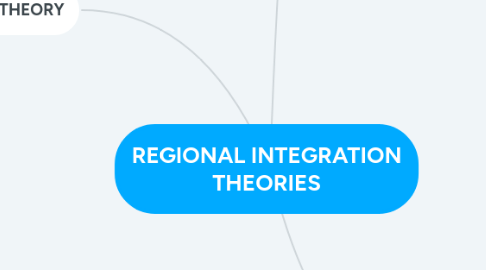
1. NEO-FUNCTIONAL THEORY
1.1. by Ernest B. Haas, Philippe C. Schmitter and Leon L. Linberg
1.2. Argues that integration to take place 2 preconditions must exist;
1.2.1. a) value change among political elites
1.2.2. b) more positives spillover effects are seen and felt.
1.3. the MORE frequent these two are present, the MORE LIKELY a full regional integration can take place.
1.4. CHARACTERISTICS
1.4.1. (1) a process over the course of time and NOT NECESSARILY AN ULTIMATE condition,
1.4.2. (2) a process where there is a change taking place among the political elites a.k.a. "INCREMENTALISM".
1.4.3. (3) spillover concept.
1.4.4. (4) linear concept of integration.
1.5. Integration = regarded as INEVITABLE process, rather than a DESIRABLE state of affairs that could be introduced by the political/technocratic elites of the involved states' societies.
1.5.1. often contrasted with inter-governmentalism.
1.6. while, it argues that regional integration is only feasible as an incremental process, its conception of integration as a LINEAR process made the explanation of setbacks impossible.
1.7. functional spillover occurs from the COOPERATION AND SOCIAL INTEGRATION of technocrats into increasingly densely connected webs of political realms.
1.8. it assumes a DECLINE in importance of NATIONALISM AND THE NATION-STATE;
1.8.1. it sees that executive power and interest groups within states to be pursuing a WELFARIST objective.
1.9. 3 key forces to the process of integration:
1.9.1. (1) Positive spillover;; ECSC > EEC > EC > EU2
1.9.2. (2) Transfer of domestic allegiances.
1.9.3. (3) Technocrats automaticity.
1.10. Positive spillover :
1.10.1. the concept that integration between states in on eco-sector will quickly create STRONG INCENTIVES for integration in the further sectors
1.10.1.1. in order to fully capture the benefits of integrations in the original sector.
1.11. Transfer of domestic allegiances :
1.11.1. the existence of a PLURALISTIC society within the relevant nation states.
1.12. Technocrats automaticity :
1.12.1. autonomous and more powerful supranational institutions overseeing integration process.
1.13. Nor-normative theory :
1.13.1. describing and explaining process of regional integration based on empirical data
1.13.1.1. i.e data of incrementalism and spillover effects.
1.14. e.g. UN - an organization of nations without a central or federal authority.
1.15. Process over time > inevitable not desirable > incrementalism > decline of nationalism > pursuit of WELFARE objectives
1.15.1. spillover concept :
1.15.1.1. full cooperation and integration preceded by partial cooperation
2. FEDERALIST THEORIES (Faddist Theories)
2.1. Introduced by Carl J. Friedrich
2.2. Argues that a federalist system will come into existence
2.2.1. when there is high political will among the political scholars sharing similar goals and purposes while agreeing on converging their national interests.
2.3. the HIGHER the level of the political will exist, the HIGHER the probability of a federal system to exist.
2.4. CHARACTERISTICS
2.4.1. 1. Ultimate objective (final mission) of integration : the establishment of huge FEDERAL GOVERNMENT.
2.4.2. 2. CENTRAL POLITICAL INSTITUTION - carries the basic functions of common Federal State.
2.4.3. 3. Integration makes members SURRENDER ITS SOVEREIGNTY and decision making power to a Central Political Institution by VOLUNTARY means.
2.4.4. 4. Every single policy formulated by the integration automatically BINDS all the member countries without exception.
2.4.5. 5. Integration can be created by an act of political will by political actors or ruling elites who share common regional purposes and needs.
2.5. Closely related to "INTERGOVERNMENTALISM".
2.5.1. in which states cooperate in specific fields while retaining their sovereignty while making decisions unanimously.
2.5.1.1. e.g. European Parliament and European Commission act as "federal government" making decisions and policies for EU member states.
2.6. Common purposes > desirable > political will > surrendering of parts of decisional authority / sovereignty > central political institutions > binding policy > Federal Government
3. TRANSACTIONALIST @ COMMUNICATION THEORY
3.1. Doesn't call for the establishment of a supranational/federal political entity as espoused by Faddist supporters
3.1.1. it's more concerned with encouragement of regional sense of community or ESPRIT DE CORP.
3.2. the HIGHER the level of communication transactions, the HIGHER the level of probability of integration taking place
3.3. CHARACTERISTICS
3.3.1. 1) integration does not place importance on political institutionalization,
3.3.2. 2) integration will take place solely based on increase rate of transaction that later will promote a sense of community among member's coutries.
3.3.3. 3) trust and responsiveness concept.

